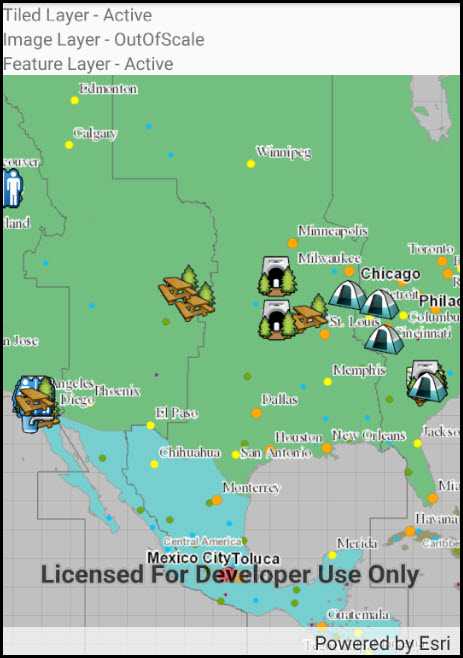Determine if a layer is currently being viewed.

Use case
The view state includes information on the loading state of layers and whether layers are visible at a given scale. For example, you might change how a layer is displayed in a layer list to communicate whether it is being viewed in the map.
How to use the sample
Pan and zoom around in the map. Each layer's view status is displayed. Notice that some layers configured with a min and max scale change to "OutOfScale" at certain scales.
How it works
- Create an
Mapwith some operational layers. - Set the map on a
MapView. - Add an event handler for the
LayerViewStateChangedevent in the map view.
Relevant API
- LayerViewStateChanged
- LayerViewStateChangedEventArgs
- Map
- MapView
About the data
The map shows a tiled layer of world time zones, a map image layer of the census, and a feature layer of recreation services.
Tags
layer, map, status, view
Sample Code
// Copyright 2016 Esri.
//
// Licensed under the Apache License, Version 2.0 (the "License"); you may not use this file except in compliance with the License.
// You may obtain a copy of the License at: http://www.apache.org/licenses/LICENSE-2.0
//
// Unless required by applicable law or agreed to in writing, software distributed under the License is distributed on an
// "AS IS" BASIS, WITHOUT WARRANTIES OR CONDITIONS OF ANY KIND, either express or implied. See the License for the specific
// language governing permissions and limitations under the License.
using Esri.ArcGISRuntime.Geometry;
using Esri.ArcGISRuntime.Mapping;
using Esri.ArcGISRuntime.UI.Controls;
using System;
using Android.App;
using Android.OS;
using Android.Widget;
namespace ArcGISRuntime.Samples.DisplayLayerViewState
{
[Activity (ConfigurationChanges=Android.Content.PM.ConfigChanges.Orientation | Android.Content.PM.ConfigChanges.ScreenSize)]
[ArcGISRuntime.Samples.Shared.Attributes.Sample(
name: "Display layer view state",
category: "MapView",
description: "Determine if a layer is currently being viewed.",
instructions: "Pan and zoom around in the map. Each layer's view status is displayed. Notice that some layers configured with a min and max scale change to \"OutOfScale\" at certain scales.",
tags: new[] { "layer", "map", "status", "view" })]
public class DisplayLayerViewState : Activity
{
// Hold a reference to the map view
private MapView _myMapView;
// Controls to show status of each layers' loading
private TextView _TextViewTiledLayer;
private TextView _TextViewImageLayer;
private TextView _TextViewFeatureLayer;
protected override void OnCreate(Bundle bundle)
{
base.OnCreate(bundle);
Title = "Display Layer View State";
// Create the UI, setup the control references and execute initialization
CreateLayout();
Initialize();
}
private void Initialize()
{
// Create new Map
Map myMap = new Map();
// Create the uri for the tiled layer
Uri tiledLayerUri = new Uri(
"https://services.arcgisonline.com/arcgis/rest/services/World_Topo_Map/MapServer");
// Create a tiled layer using url
ArcGISTiledLayer tiledLayer = new ArcGISTiledLayer(tiledLayerUri)
{
Name = "Tiled Layer"
};
// Add the tiled layer to map
myMap.OperationalLayers.Add(tiledLayer);
// Create the uri for the ArcGISMapImage layer
Uri imageLayerUri = new Uri(
"https://sampleserver6.arcgisonline.com/arcgis/rest/services/Census/MapServer");
// Create ArcGISMapImage layer using a url
ArcGISMapImageLayer imageLayer = new ArcGISMapImageLayer(imageLayerUri)
{
Name = "Image Layer",
// Set the visible scale range for the image layer
MinScale = 40000000,
MaxScale = 2000000
};
// Add the image layer to map
myMap.OperationalLayers.Add(imageLayer);
// Create Uri for feature layer
Uri featureLayerUri = new Uri(
"https://sampleserver6.arcgisonline.com/arcgis/rest/services/Recreation/FeatureServer/0");
// Create a feature layer using url
FeatureLayer myFeatureLayer = new FeatureLayer(featureLayerUri)
{
Name = "Feature Layer"
};
// Add the feature layer to map
myMap.OperationalLayers.Add(myFeatureLayer);
// Create a map point the map should zoom to
MapPoint mapPoint = new MapPoint(-11000000, 4500000, SpatialReferences.WebMercator);
// Set the initial viewpoint for map
myMap.InitialViewpoint = new Viewpoint(mapPoint, 50000000);
// Event for layer view state changed
_myMapView.LayerViewStateChanged += OnLayerViewStateChanged;
// Provide used Map to the MapView
_myMapView.Map = myMap;
}
private void OnLayerViewStateChanged(object sender, LayerViewStateChangedEventArgs e)
{
// For each execution of the MapView.LayerViewStateChanged Event, get the name of
// the layer and its LayerViewState.Status
string lName = e.Layer.Name;
string lViewStatus = e.LayerViewState.Status.ToString();
// Display the layer name and view status in the appropriate TextView control
switch (lName)
{
case "Tiled Layer":
_TextViewTiledLayer.Text = lName + " - " + lViewStatus;
break;
case "Image Layer":
_TextViewImageLayer.Text = lName + " - " + lViewStatus;
break;
case "Feature Layer":
_TextViewFeatureLayer.Text = lName + " - " + lViewStatus;
break;
default:
break;
}
}
private void CreateLayout()
{
// Create a new vertical layout for the app
LinearLayout layout = new LinearLayout(this) { Orientation = Orientation.Vertical };
// Create the controls to show the various layers' loading status
_TextViewTiledLayer = new TextView(this);
layout.AddView(_TextViewTiledLayer);
_TextViewImageLayer = new TextView(this);
layout.AddView(_TextViewImageLayer);
_TextViewFeatureLayer = new TextView(this);
layout.AddView(_TextViewFeatureLayer);
// Add the map view to the layout
_myMapView = new MapView(this);
layout.AddView(_myMapView);
// Show the layout in the app
SetContentView(layout);
}
}
}